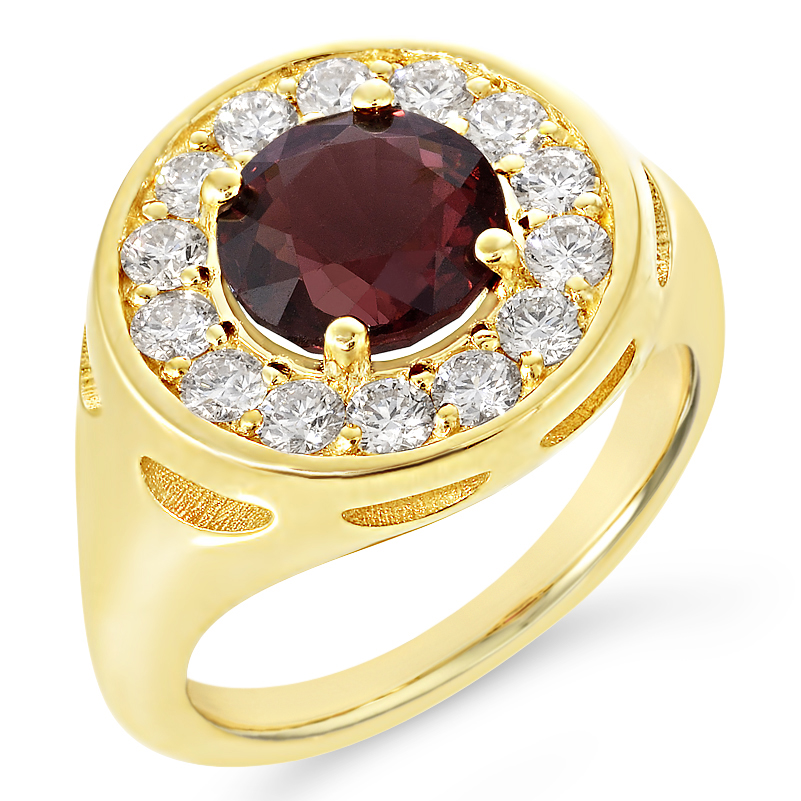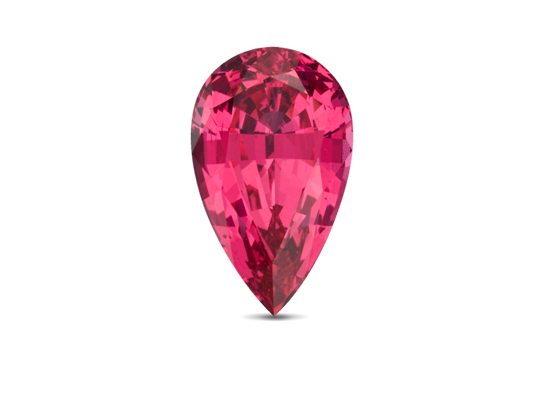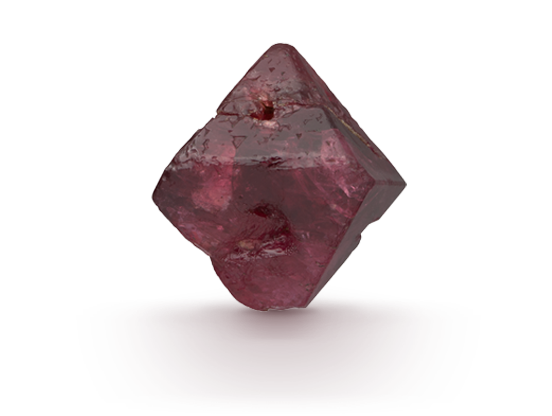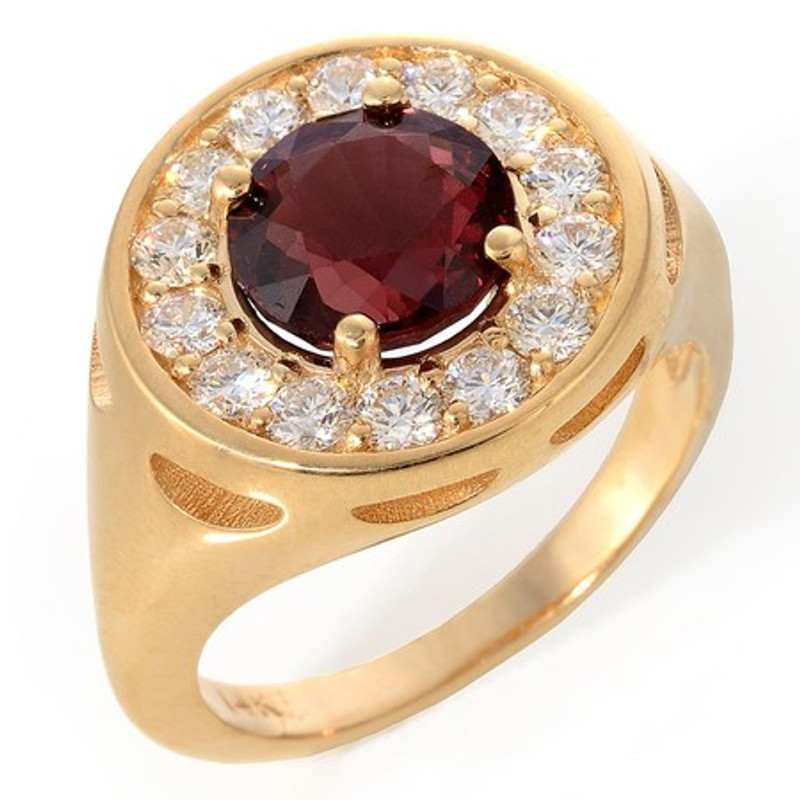Those of us born in August are lucky to have a choice of two fabulous birthstones, peridot and spinel. With August being my birth month, I am particularly fond of these two lesser known, but highly desirable gemstones. This blog provides information about spinel, which was only recently added as an August birthstone. Peridot is the topic of its own, separate blog; August Birthstone: Peridot - facts and lore. Spinel is also the traditional gift for the 22nd wedding anniversary.
Spinel is a mineral group that has produced some exceptional gemstones, yet until recently, wasn’t recognized for its beauty and value by the general public. From ancient times until the creation of the modern science of gemology in the 18th century, spinel was often mistaken for more well-known gemstones, primarily ruby and sapphire. Then, during the 19th century, a process was developed to create synthetic spinel, which was used to imitate other, more valuable gemstones. The connection to gemstone imitations generated a negative public perception of spinel. These series of events make spinel a good candidate for the title of “History’s Most Underappreciated Gem”.
Spinel comes in a wealth of colors; intense red, vibrant pink, orange, purple, violet, yellow, brown, green, blue, bluish green and black. Jewelry featuring spinel should make anyone proud, especially those of you celebrating an August birthday or a 22nd wedding anniversary. Click the link to browse the current 100 East Fine Jewelry Spinel Collection. Our recent designs included this outstanding spinel piece.

History and Lore
The earliest known use of spinel as ornamentation was red hued crystals found in Buddhist tombs in Afghanistan, dating back to around 100 B.C. Red spinel was also a favorite of ancient Romans as early as the first century B.C. The name “spinel” is derived from the Latin word spina, meaning thorn, a reference to the shape of spinel crystals. Romans introduced blue and green spinel to England during their occupation, dating back to 51 B.C. The first known spinel mining is believed to have occurred in Afghanistan between 750 and 950 A.D.
Some early cultures considered all red gemstones ruby. Ancient Sanskrit writings referred to spinel as “daughter of ruby”; adored, yet distinct. Mines in ancient central Asia, in what is currently Afghanistan, yielded exceptionally large spinel crystals, which became known as ‘Balas rubies’, a reference to the mine’s location. Some ‘Balas rubies’ became treasured properties of royal courts extending from Rome to China, often passing through many hands as spoils of war. The confusion created from calling all red gemstones ruby and assigning ruby-related names to spinel, resulted in them often being misidentified as some of the world’s most illustrious “ruby” pieces.
The Crown Jewels of the United Kingdom are a good example of the confusion of ruby and spinel. The approximately 170 carat “Black Prince’s Ruby” was owned by a succession of Moorish and Spanish kings before Edward, Prince of Wales (aka the Black Prince), received the stone in 1367 AD as payment for an important battle victory. Subsequently, many English monarchs, including Henry VIII, cherished the gem. It outlasted them all, surviving fires, attempted theft, and World War II bombing raids, to become one of the centerpieces of The Crown Jewels of England. The spinel known as the “Black Prince’s Ruby” is currently set just above the 317.40 carat Cullinan II diamond in the Imperial State Crown, which currently resides in the Tower of London.
Similarly, the “Timur
Ruby”, a 361-carat unfaceted polished red gemstone set in a necklace once owned
by Mogul emperors and now part of The Crown Jewels of the United
Kingdom, was determined to actually
be a red spinel.
In 1783, mineralogist Jean Baptiste Louis Rome de Lisle identified spinel as a different mineral than ruby, giving birth to the modern science of gemology.
In the 1800’s, a process to create synthetic spinel was discovered. Manufacturing synthetic spinel didn’t become popular until the 1920’s, when the process was refined to synthesize it in a variety of colors. Colored synthetic spinel was then used to create imitations of a variety of popular gemstones, such as sapphire, ruby, emerald, aquamarine and tourmaline. These imitation gems were mounted in inexpensive settings and sold as "birthstone" jewelry and class rings. The use of synthetic spinel to imitate other gems became so widespread that many consumers weren’t aware natural spinel even existed. In recent years, spinel’s negative perceptions have been changing, as it’s being recognized in the global gem market as a beautiful, rare gemstone in its own right.
Man-made spinel also has important industrial applications. It’s used extensively in military and commercial products, such as a refractory materials for heat-resistant coatings.
Some of the lore connected specifically to red spinel includes the belief it was a remedy for all types of blood loss and inflammatory diseases. It was also believed to ease anger, promote harmony and protect the owner from harm, reconcile differences, and soothe away sadness.
Use in Jewelry Today
Dealers and connoisseurs now recognize spinel as an exceptionally rare and valuable gem. Today’s consumer is more attuned to the beauty of fine quality spinel; considering it worthy of use in modern jewelry on its own merit, rather than merely a less costly alternative to ruby or sapphire. Spinel is durable, making it perfect for all types of jewelry, even those subject to daily wear, such as rings. Its strongest selling point, though, is its brilliant array of colors.
Well-formed spinel crystals are highly sought by collectors and when fashioned as gemstones, they’re in great demand among gemologists and gem connoisseurs. While common in sizes up to 2 carats, larger gemstones can also be found. Although famous spinels of history are impressively large, today, it’s rare in sizes above five carats. Prices rise sharply for fine-colored red, pink, and blue spinel above five carats.
The most popular fashioned gemstone shapes are oval, round, and cushion cuts.

Photo credit: GIA
Because of spinel’s rarity, it is often set in custom, handcrafted jewelry, making it a striking addition to any collection.
Spinel is stable when exposed to light and chemicals. High heat can cause some colors to fade. Warm soapy water is always a safe cleaning alternative for all gemstone types, including spinel. To learn more about cleaning gemstone jewelry, feel free to visit our blog article Cleaning Fine Gemstone Jewelry. To learn about caring for your fine jewelry, please read our blog Caring For Fine Gemstone Jewelry.
Color Characteristics and Treatments
As discussed previously, spinel offers a broad range of hues, from orange to intense “stoplight” red, vibrant pink, and all shades of purple, blue, and violet through bluish green. Some spinel colors are more valuable and important to the trade than others. In general, vivid red is the most valued spinel color, followed by fine cobalt-blue, then vibrant pink to lavender stones. The most highly valued blue spinel colors parallel blue sapphire, with intense violet-blue to pure blue colors that are neither too dark nor too light. During the past few years, due to increasing popularity of black gems, black spinel has been fashioned as gems too.
Various tones of transparent gray spinel recently began appearing in the market. Gray is actually a very desaturated blue to violet, so these stones come with some color flashes. Dealers report sizes between 2 and 4 carats as common, with anything over 7 carats very unusual. Gray spinel typically has eye visible inclusions, but clean stones are also available.
Intense reds and pinks are caused by traces of chromium, the same trace element that colors ruby and emerald. The higher the chromium content, the stronger the red hue. Orange and purple stones owe their color to a mixture of iron and chromium. Violet to blue spinel can be colored by trace amounts of iron, and vibrant blues owe their saturated color to trace amounts of cobalt.
Transparent material is expected and spinel with no visible inclusions is preferred. The more prominent the inclusions, the less valuable the gem. Pastel colors of spinel are expected to be relatively free of inclusions but saturated reds and blues are rare, so some inclusions are accepted. Some gems have beautiful inclusions that reflect the gem’s octahedral crystal growth. They might appear in groups that resemble human fingerprints.
Spinel can contain fractures, but is rarely treated. Despite a few heat-treated examples reported in trade journals, the vast majority of spinel on the market is believed to be natural. Of course, as mentioned above, substantial quantities of synthetic spinel can be found.
Natural spinel remains one of the more affordable of the fine gems, especially compared to untreated ruby and sapphire.
Formation, Mining and Cutting
Like diamond, spinel’s characteristic crystal shape is an octahedron, which looks like two back-to-back pyramids. Well-formed spinel crystals are fairly common in nature and in Myanmar (Burma) they’re said to be “nat thwe” or “polished by the spirits.”

Photo credit: GIA
Spinel is found in areas that are famous for sapphire deposits. Since spinel, ruby and sapphire have similar physical properties and geological environments, the confusion surrounding spinel’s identity in ancient times makes sense.
Mogok, Myanmar (Burma) is known to be the oldest source of pink and red spinel. Namya is another, newer source in Myanmar. The mountains of central Asia (Pakistan, Tajikistan, and Afghanistan) are also important historical sources.
Today, the majority of spinel is mined from deposits in Myanmar (Burma) and Sri Lanka, where spinel comes in a striking array of colors including oranges, pinks, blues, lavenders, mauves and vivid reds. Other major sources include, Vietnam, Thailand, Tanzania, Afghanistan, Pakistan, Madagascar and the Pamir Mountains of Tajikistan. Some sources are known for producing spinel in exceptional colors and qualities, such as:
- Myanmar’s (Burma) Mogok Stone Tract, where ruby, sapphire and other gem minerals, including the other August birthstone, peridot, are found, is a prolific source of the best red, pink and orange spinel. Gems unearthed there are so naturally lustrous that locals call them “spirit polished.”
- Sri Lanka is a veritable Treasure Island of different gem species and varieties, including sapphire, ruby and garnet. The best blue and violet spinel come from Sri Lanka, along with pink and purple
- The Luc Yen region in northern Vietnam has produced deep red, purple, pink, violet and violet-blue since the 1980s. Vivid blue spinel was found there in the 2000s. Blue spinel varies in tone and saturation due to its cobalt content. Vibrant cobalt blue commands several times more per carat price than other blue to lavender spinel.
- A 2007 discovery in Mahenge, Tanzania of beautifully saturated pink to red spinel captured the attention of mainstream dealers, thus shattering spinel’s reputation as a collector’s stone. Mines there also produce some sensational purple and blue hues. These discoveries are credited by some for generating more excitement and awareness of spinel. The color intensity associated with the Mahenge material fundamentally changed the price structure and popularity of spinel.
- Thailand is a significant source of black spinel.
Commercial quality spinel is commonly cut to standard sizes; usually as 6×4 mm and 7×5 mm mixed-cut cushion and oval shapes for use in jewelry. They are particularly suitable for center stones in rings. When properly proportioned these stones possess excellent brilliance. Because of the scarcity of spinel on the market, though, most fine quality rough is cut in non-standard sizes to save weight.
Famous Spinel
- The Black Prince’s ‘Ruby’ - This smoothly polished and roughly octagonal shaped crimson red spinel, is believed to have been mined in the mountains of Afghanistan. The history of this 170-carat spinel is touched upon in the History section.
- Samarian Spinel - The 500-carat Samarian Spinel, part of the Iranian Crown Jewels, is thought to be the largest fine spinel in the world.
- Carew Spinel - This 133.50-carat gem, in the collection of the Victoria & Albert Museum, is engraved with the names of Mogul Emperors.
- Russian Great Imperial Crown - A 398.72 carat dark red spinel set on top of a crown in the collection of the Moscow Kremlin Armory State Diamond Fund is the centerpiece for the Great Imperial Crown commissioned for the coronation of Catherine the Great in 1762. It’s adorned with 4,936 diamonds arranged in splendid patterns across the entire surface of the crown and also contains a number of fine, large white pearls.
- Imperial Mughal Spinel Necklace - This necklace, set with 11 polished spinels weighing a total of 1,131.59 cts, sold for $5.2 million at Christie’s in 2011.
Credit to American Gem Trade Association, Gemworld International and Gemological Institute of America.

